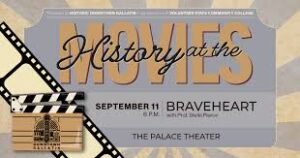By: Ella Coleman
Copy Editor
The season of haunted houses, carving pumpkins, and Halloween costumes is upon us, and what better way to celebrate than to watch a classic slasher film?
On October 9, Vol State collaborated with the Palace Theater in downtown Gallatin to show a screening of Scream, first released in 1996 and directed by Wes Craven. The plot follows high school student Sidney Prescott, who’s being hunted by a masked killer known as Ghostface.
This showing is part of an ongoing event called ‘History at the Movies’, where each month, Vol State will show a different historical movie and have a discussion afterward about the importance of the historical event.
In September it was the movie Braveheart, but this month, professors wanted to do something different.
“I wanted to do something a little bit different and show a horror film during October,” Brady Duncan, the professor leading the discussion of the movie, says in an interview. “I’m going to be focusing on cinema history. Specifically, I’m going to be discussing the history of slashers as a genre of horror cinema.”
Brady Duncan delved into the history of the genre, why and how it became popular with the people and the themes that are present in slasher films.
The discussion begins with how slasher films can be considered either a subgenre of horror or suspenseful thriller. By showing grisly murders, the movie is manipulating the audience’s emotions and makes them to feel things such as fear, sadness, nervousness, and uneasiness (think Psycho from 1960). Despite how you define a slasher film, there are a few themes that tie them together.
Often times in slashers, there is an emphasis on graphic violence, typically exaggerated. This violence is inflicted from one human to another human with no supernatural elements. This is a big break from horror movies from the 1940s through the 1960s, where the villains were typically monsters or supernatural. These kinds of villains or antagonists were put in media as a metaphor or used to represent something that humans had anxieties about, but weren’t real threats that we would face every day. Human malice, however, is something that is very real.
Slasher movies tend to show the killer stalking and killing off a cast of characters one by one. These characters may be funny and likeable, but usually aren’t shown with a lot of depth or character building. They’re supposed to feel slightly relatable to the target audience of these movies, teenagers and young adults, but not relatable enough for us to feel devastated about their ultimate deaths.
“The cycle of violence is often a very common theme in the slasher genre,” Duncan said during the discussion.
Another theme seen in slashers is practical visual effects to create what’s seen on screen, such as fake blood, elaborate makeup, props, and costuming, instead of relying solely on post-production editing. There are a few exceptions of course, like A Nightmare on Elm Street, but generally slashers rely on the same techniques.
Profanity, violence, and sexuality are also incredibly prominent in slashers, more so than other genres.
Early influential slashers such as The Texas Chainsaw Massacre and Black Christmas were released in the 1970s. These kinds of movies had a lot of influence from foreign murder mystery and crime movies (mostly British, German, and Italian). Giallo, a genre of Italian film with murder mystery, slasher, and psychological horror, was popularized in the 1970s and consisted of flashy characters, stylish and surreal visuals, and a suspenseful plot.
A big question during the discussion was: why did these movies start to become popular in the 1970s?
Brady Duncan’s research originally told him that they were popularized in the ‘70s because of the activity of serial killers during that time. Faces like Ted Bundy, John Wayne Gacy, and Edmund Kemper were possibly seen as inspiration for slashers in that decade. There were also reports of religious groups turned cults around that time (the Manson family, for example).
These types of movies were also commercially popularized during that time because of a certain type of movie theater called grindhouses. They showed low budget movies, like slashers that were cheap to buy, from start to finish on a loop all day, so people were able to visit at any time during the day.
Additionally, Brady Duncan also learned something called the Hayes Code, or the Motion Picture Production Code, which was a list of rules that most American films had to follow to get any form of large scale distribution. The Hayes Code included prohibition of showing profanity, trafficking drugs, methods of smuggling, sexual activity, and more. It lasted from the 1930s until the 1960s, but gradually became weakened. Why?
Besides showing slasher movies, the grindhouses mentioned above also showed foreign movies who didn’t have to follow the Hayes Code, like Godzilla or King Kong. These grindhouses accumulated lots of cash flow because most people went to see these movies that were able to show horror, profanity, sexuality, and gore. So, the Hayes Code fell out of favor when people stopped visiting their big budget movie theaters.
“Movies like Scream became popular in the 1970s… because they were cheap, and they were gory, and they were easy. But also, because for the first time since the 1930s, they could be,” Brady Duncan told the audience.
The ‘History at the Movies’ event hosted by Vol State will show one movie each month at the Palace Theater. November is The Patriot, February is Malcom X, March is A League of their Own, and April is The Hunt for Red October.
The Palace Theater, located in downtown Gallatin, is the oldest silent theater in Tennessee. Tickets and concessions are cheap, and attending these movies and discussions is a great way to bond with the community.
Professor Stella Pierce, an organizer of this ongoing event, says, “You’ll learn a little bit, it’ll be interesting, but just come and engage with the community. We’re trying to sneak in educational opportunities so people are learning outside of the standard classroom. It’s supposed to be fun, supposed to be about the community, and a unique way to learn.”






Be First to Comment